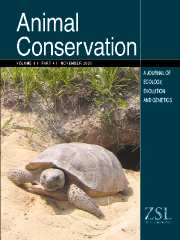Crossref Citations
This article has been cited by the following publications. This list is generated based on data provided by
Crossref.
Schwartz, Michael K.
Tallmon, David A.
and
Luikart, Gordon
1999.
Using genetics to estimate the size of wild populations: many methods, much potential, uncertain utility.
Animal Conservation,
Vol. 2,
Issue. 4,
p.
321.
Girman, D. J.
Vilà, C.
Geffen, E.
Creel, S.
Mills, M. G. L.
Mcnutt, J. W.
Ginsberg, J.
Kat, P. W.
Mamiya, K. H.
and
Wayne, R. K.
2001.
Patterns of population subdivision, gene flow and genetic variability in the African wild dog (Lycaon pictus).
Molecular Ecology,
Vol. 10,
Issue. 7,
p.
1703.
Emerson, Brent C.
Paradis, Emmanuel
and
Thébaud, Christophe
2001.
Revealing the demographic histories of species using DNA sequences.
Trends in Ecology & Evolution,
Vol. 16,
Issue. 12,
p.
707.
Sinclair, Elizabeth A.
Swenson, Eric L.
Wolfe, Michael L.
Choate, David C.
Bates, Bill
and
Crandall, Keith A.
2001.
Gene flow estimates in Utah's cougars imply management beyond Utah.
Animal Conservation,
Vol. 4,
Issue. 3,
p.
257.
Carpenter, Daniel W.
Jung, Robin E.
and
Sites, Jack W.
2001.
Conservation genetics of the endangered Shenandoah salamander (Plethodon shenandoah, Plethodontidae).
Animal Conservation,
Vol. 4,
Issue. 2,
p.
111.
Jehle, R.
Arntzen, J. W.
Burke, T.
Krupa, A. P.
and
Hödl, W.
2001.
The annual number of breeding adults and the effective population size of syntopic newts (Triturus cristatus, T. marmoratus).
Molecular Ecology,
Vol. 10,
Issue. 4,
p.
839.
Garrigan, Daniel
Marsh, Paul C.
and
Dowling, Thomas E.
2002.
Long‐term effective population size of three endangered Colorado River fishes.
Animal Conservation,
Vol. 5,
Issue. 2,
p.
95.
Vasco, Daniel A.
Crandall, Keith A.
and
Fu, Yun-Xin
2002.
Computational and Evolutionary Analysis of HIV Molecular Sequences.
p.
173.
Sarmiento, Esteban E.
2002.
Gorilla Biology.
p.
432.
Storz, Jay F.
Ramakrishnan, Uma
and
Alberts, Susan C.
2002.
GENETIC EFFECTIVE SIZE OF A WILD PRIMATE POPULATION: INFLUENCE OF CURRENT AND HISTORICAL DEMOGRAPHY.
Evolution,
Vol. 56,
Issue. 4,
p.
817.
Storz, Jay F.
Ramakrishnan, Uma
and
Alberts, Susan C.
2002.
GENETIC EFFECTIVE SIZE OF A WILD PRIMATE POPULATION: INFLUENCE OF CURRENT AND HISTORICAL DEMOGRAPHY.
Evolution,
Vol. 56,
Issue. 4,
p.
817.
Pearse, Devon E.
and
Crandall, Keith A.
2004.
Beyond FST: Analysis of population genetic data for conservation.
Conservation Genetics,
Vol. 5,
Issue. 5,
p.
585.
Pertoldi, Cino
and
Topping, Chris
2004.
Impact Assessment Predicted by Means of Genetic Agent-Based Modeling.
Critical Reviews in Toxicology,
Vol. 34,
Issue. 6,
p.
487.
Godoy, José A.
Negro, Juan J.
Hiraldo, Fernando
and
Donázar, José A.
2004.
Phylogeography, genetic structure and diversity in the endangered bearded vulture (Gypaetus barbatus, L.) as revealed by mitochondrial DNA.
Molecular Ecology,
Vol. 13,
Issue. 2,
p.
371.
Pertoldi, Cino
and
Topping, Chris
2004.
The use of agent-based modelling of genetics in conservation genetics studies.
Journal for Nature Conservation,
Vol. 12,
Issue. 2,
p.
111.
Matocq, M. D.
2004.
Reproductive success and effective population size in woodrats (Neotoma macrotis).
Molecular Ecology,
Vol. 13,
Issue. 6,
p.
1635.
Pearse, Devon E.
and
Crandall, Keith A.
2004.
Beyond FST: Analysis of population genetic data for conservation.
Conservation Genetics,
Vol. 5,
Issue. 5,
p.
585.
Berry, Oliver
and
Gleeson, Dianne M.
2005.
Distinguishing historical fragmentation from a recent population decline – shrinking or pre-shrunk skink from New Zealand?.
Biological Conservation,
Vol. 123,
Issue. 2,
p.
197.
LEBERG, PAUL
DeYoung
and
Brennan
2005.
GENETIC APPROACHES FOR ESTIMATING THE EFFECTIVE SIZE OF POPULATIONS.
Journal of Wildlife Management,
Vol. 69,
Issue. 4,
p.
1385.
DEYOUNG, RANDY W.
HONEYCUTT, RODNEY L.
and
Brennan
2005.
THE MOLECULAR TOOLBOX: GENETIC TECHNIQUES IN WILDLIFE ECOLOGY AND MANAGEMENT.
Journal of Wildlife Management,
Vol. 69,
Issue. 4,
p.
1362.


